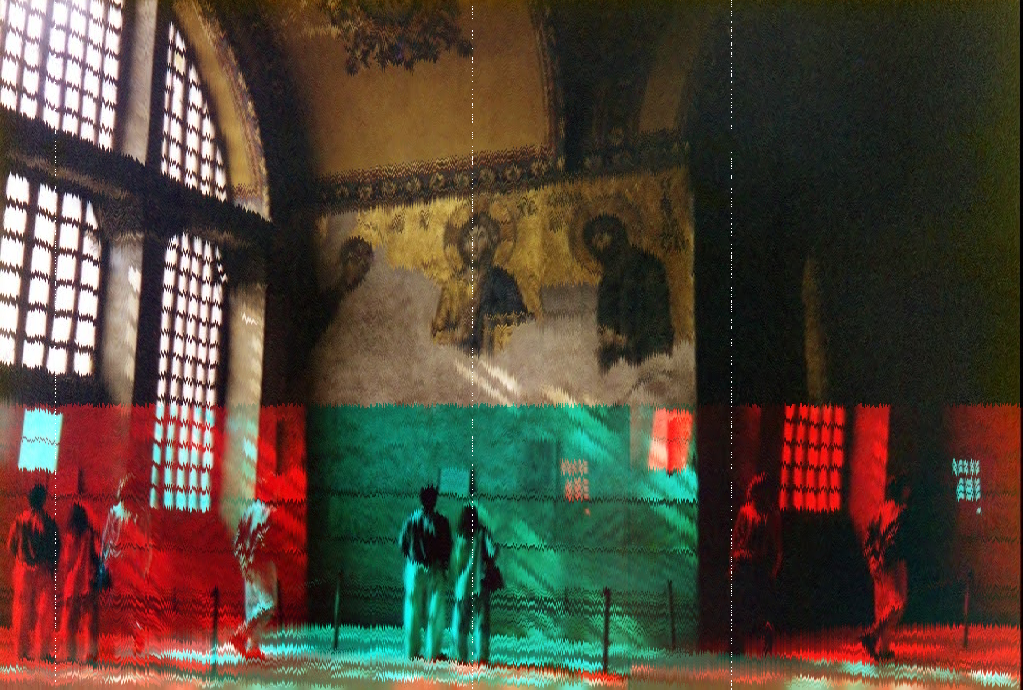Douglas Weissman
Or Not to Say Where East Meets West | Or How Not to Write a Travel Essay
This essay could have been called, “Visiting where East Meets West,” and I could have focused on all the cliches people talk about when visiting Turkey, but that would have felt disingenuous. This essay also could have been called, “How to Write a Travel Essay.” I could have given you a simple formula with easy steps to follow:
Step 1. Pick a place;
Step 2. Talk about your experience in that place;
Step 3. Immerse the reader in that place;
Step 4. Relate how that experience is personal to you;
Step 5. Leave the reader with a message.
This travel essay has a place: it is a record of my experience. It also has a message. But does it have a point? In Istanbul’s Hagia Sophia, the depth of art, the art in the architecture, what the experience instilled in me—even if only for a minute—a belief in the divine found in the devotion of others. The illustration of the holy figures in the mosaic leapt from the walls in the very architecture in which the art stood turning rails into elegant whispers of curling iron. Circular marble inlays encompassed the far reach of the former empire with each color taken from a different quarry. I stood beneath the disparate worlds under a single ruler—under a single roof—with the gilded dome blessed with the word of Allah.
But then I left the Hagia Sophia. I left Turkey. Then the questions became:
Question 1. What did I leave behind?
Question 2. What did I take with me?
Question 3. Does the reader need to know?
Question 4. How can the reader follow two different lines at once?
Question 5. How can I make the reader care?
Instead of leading you to the ending, we can look at the beginning differently. Where does the story actually begin? Perhaps when I first saw the Hagia Sophia, when I stood beside the Bosporus Strait and learned that during December in Turkey, I could feel my fingernails freeze. I turned the corner after a frigid breeze pierced me through the heart and found the iconic minarets and dome soaring above me, above the city, and couldn’t tell if I had frozen in place from the cold or pure awe. And I, like kings and caliphs before me, bowed to the beauty of the architecture and the way its very existence enriched the lives of those living in Istanbul.
Or maybe the story actually starts later, once I’ve entered the Hagia Sophia, when the sparse sunlight of winter poured through the windows. When I saw that light cover my wife, her red overcoat glowing against the darkness beneath the dome. And I stood in that moment, a dying star surrounded by endless, expanding space.
Perhaps I shouldn’t introduce a new character this late in the essay, or maybe the astronomy simile is not the best use of figurative language, but the purpose is to convey the essential grandiosity of the space, much like looking up at a night’s sky when in an open field, where you can see every detail, divot, crevice, and fracture in the universe and every imperfection only makes it look more perfect. But what about the mosaic that showed me religion? Then I’m forced to face new questions.
Question 1. Did the mosaic actually matter to the story?
Question 2. What does the mosaic represent?
Question 3. What did I take away from the mosaic?
Pictures of the mosaic pay the figures of Mary, Jesus, and St. John credence only in the fact that they show they exist to those who have never visited the monument. But the essence of the figures, of the flickering gold behind them, of their sad eyes and long faces, made them real as they towered over me—these holy figures steeped in sadness. And then their existence felt real. And then I asked myself more questions.
Question 1. Can holy figures be sad?
Question 2. If a holy figure can be sad, couldn’t I be sad too?
Question 3. If I can be sad too, then can I be holy?
Question 4. If I can accept them as sad, and myself as sad, and them as holy, and myself as holy, then can I accept myself as real?
Question 5. If I can accept them as sad, and myself as sad, and them as holy, and as holy, and myself as real, then can I accept them as real?
Then my wife grabbed my hand—her glove against my glove—a tender squish beneath the sad gaze of Mary, Jesus, and St. John. Then the gold flickered with light and I flickered a smile. The cold had gone away, replaced by a moment of warmth.
“A moment” is not very descriptive: perhaps I should say one second of warmth. A period of time that felt both fleeting and eternal, when the figures stepped out from against the wall and we all held hands together, in a devotion to the beauty that can be created for gods or goddesses, the divine, the supportive, or those present.
And maybe in a better travel essay with a title like “Don’t Fault the Falafel,” the writer would start with the image of a watch and weave in the theme of time and how—by this point—they checked their watch and the entire feeling of eternity slipped away and they would spend the rest of their lives chasing that feeling. But I would rather leave you on the image of holding hands and what that could mean to you—what that meant to me—and what I took with me when I stepped away from the warmth of Hagia Sophia and back into the depths of December.
